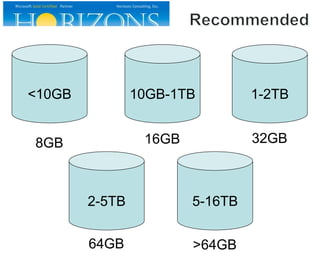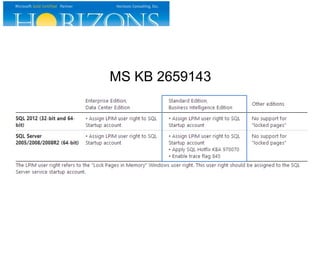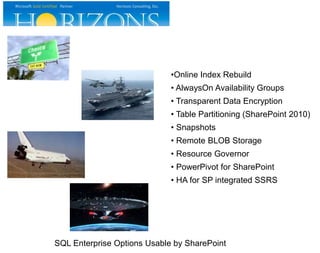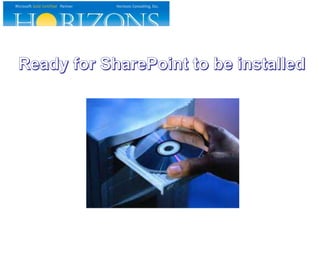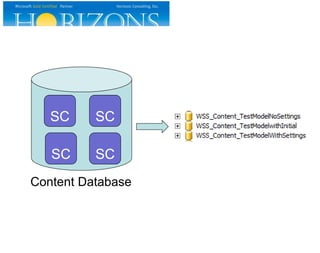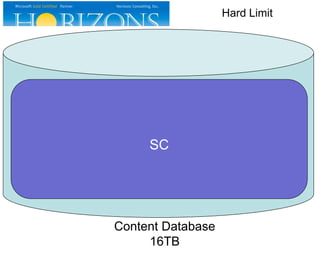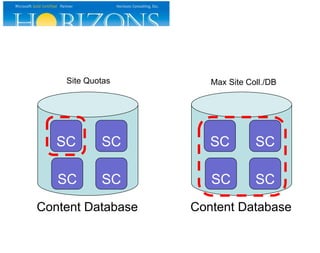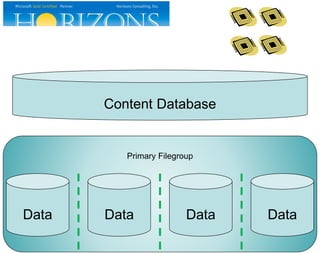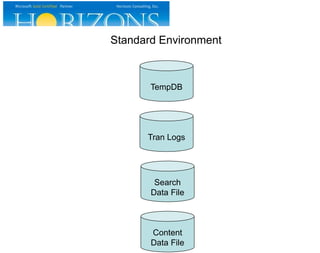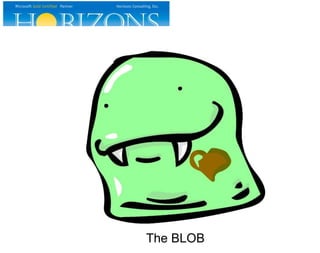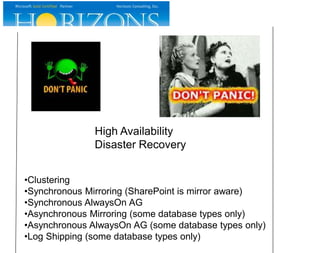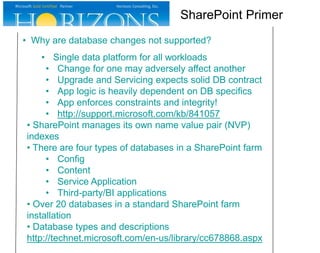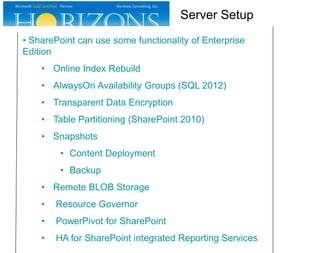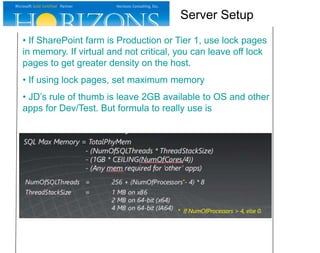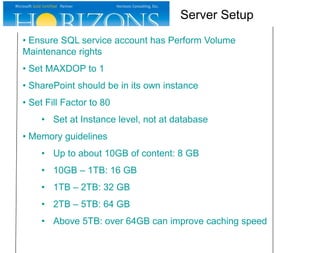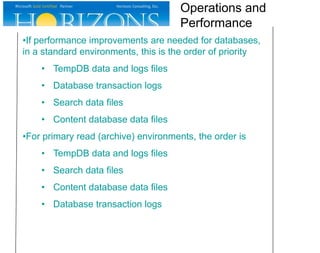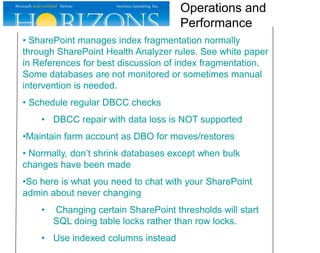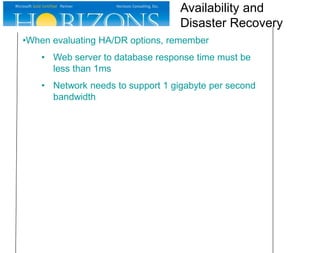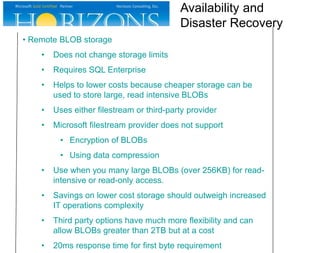What SQL DBA's need to know about SharePoint
- 1. What SQL DBA’s need to know about SharePoint Presented by: JD Wade, Lead SharePoint Consultant Horizons Consulting Mail: [email protected] Blog: http://wadingthrough.com LinkedIn: http://linkedin.com/in/jdwade Twitter: @JDWade
- 2. Agenda • SharePoint Primer • Before Turning It Over • Helping Out the SharePoint Admin & Yourself • Performance Considerations • Availability and Disaster Recovery
- 5. Single Business Productivity Platform leading to common: - End-user Experience - Rich Integrated Capabilities - Toolset and Development - Deployment and Management Users TeamsCorporate Departments Empowerment Knowledge Management Portal Regulatory Compliance Repository Corporate Web Presence Sales Division Portal Custom SAP Front-End Team “ABC” Site Project “X” Site Weekly Issue Tracking Meeting Business Intelligence Dashboard R&D Community Geneva Office Site Employee Portal Extranet Collab Site
- 9. 10GB 1TB 1,000 users 10,000 users
- 11. SharePoint/Database Client/Public HOSTS Use Multiple Networks (Client versus Backend)
- 12. Use 64KB allocation units 25% Free Space
- 13. SQLIO
- 14. Improves Database File Size Changes Use these two settings together
- 15. MS KB 2659143
- 16. SQL Enterprise Options Usable by SharePoint •Online Index Rebuild • AlwaysOn Availability Groups • Transparent Data Encryption • Table Partitioning (SharePoint 2010) • Snapshots • Remote BLOB Storage • Resource Governor • PowerPivot for SharePoint • HA for SP integrated SSRS
- 18. SQL Server Instance Settings
- 19. TempDB
- 21. 1 SQL per 4 Web Servers
- 26. Model database ignored Autogrowth is insurance only Check recovery model
- 27. Helping Out the SharePoint Admin & Yourself
- 29. SC SC SC SC Content Database Typical Content Database
- 30. SC Content Database 100GB Likes to run solo
- 31. SC Content Database 200GB Any bigger and needs to be on a diet
- 32. SC Content Database 2TB All Usage Scenarios
- 34. SC SC SC SC Content Database SC SC SC SC Content Database Site Quotas Max Site Coll./DB
- 36. Statistics
- 37. DBCC CHECKDB ALTER AUTHORIZATION Shrink database = BAD Use Backup Compression
- 39. Index Columns Make multiple views
- 41. Data: 20 ms Logs: 20 ms Data: 10 ms Logs: 10 ms Data: 10 ms Logs: 5 ms Disk Latency Requirements
- 42. TempDB Data Logs Use Separate Drive
- 43. Primary Filegroup Data Data Data Content Database Data
- 44. Standard Environment TempDB Tran Logs Search Data File Content Data File
- 45. Read (Archive) Environment TempDB Tran Logs Search Data File Content Data File
- 46. The BLOB
- 47. Native Remote BLOB Storage
- 48. Third-Party Remote BLOB Storage
- 49. High Availability Disaster Recovery •Clustering •Synchronous Mirroring (SharePoint is mirror aware) •Synchronous AlwaysOn AG •Asynchronous Mirroring (some database types only) •Asynchronous AlwaysOn AG (some database types only) •Log Shipping (some database types only)
- 51. Notes
- 52. • Why are database changes not supported? • Single data platform for all workloads • Change for one may adversely affect another • Upgrade and Servicing expects solid DB contract • App logic is heavily dependent on DB specifics • App enforces constraints and integrity! • http://support.microsoft.com/kb/841057 • SharePoint manages its own name value pair (NVP) indexes • There are four types of databases in a SharePoint farm • Config • Content • Service Application • Third-party/BI applications • Over 20 databases in a standard SharePoint farm installation • Database types and descriptions http://technet.microsoft.com/en-us/library/cc678868.aspx SharePoint Primer
- 53. • SharePoint can use some functionality of Enterprise Edition • Online Index Rebuild • AlwaysOn Availability Groups (SQL 2012) • Transparent Data Encryption • Table Partitioning (SharePoint 2010) • Snapshots • Content Deployment • Backup • Remote BLOB Storage • Resource Governor • PowerPivot for SharePoint • HA for SharePoint integrated Reporting Services Server Setup
- 54. • Format database and log drives with 64KB allocation units. Up to 30% performance improvement especially for backup and restore. Discuss pages and extents •NTFS drives should always have 25% free space • Heavy TempDB consumer, always do the following • Split data files into one file for each core on server • Total TempDB size should be 25% of the largest content database • Equally distribute space to each data file • Log files should be 25% of total database size • Set AutoGrowth to fixed amount Server Setup
- 55. • If SharePoint farm is Production or Tier 1, use lock pages in memory. If virtual and not critical, you can leave off lock pages to get greater density on the host. • If using lock pages, set maximum memory • JD’s rule of thumb is leave 2GB available to OS and other apps for Dev/Test. But formula to really use is Server Setup
- 56. • Ensure SQL service account has Perform Volume Maintenance rights • Set MAXDOP to 1 • SharePoint should be in its own instance • Set Fill Factor to 80 • Set at Instance level, not at database • Memory guidelines • Up to about 10GB of content: 8 GB • 10GB – 1TB: 16 GB • 1TB – 2TB: 32 GB • 2TB – 5TB: 64 GB • Above 5TB: over 64GB can improve caching speed Server Setup
- 57. • Server core minimum requirements • Up to 10GB content or below 1,000 users: 4 cores • Up to 1TB content or up to 10,000 users: 8 cores • Work with SharePoint Admins to create a database naming scheme. Here are some examples: • Prod_ConfigDB • Prod_ContentDB_Portal • Prod_ContentDB_WebSite • Prod_ServApp_ManagedMetadata • Prod_App_NintexWorkflow • Manually deploy service apps, use AutoSPInstaller or pre-create databases to get rid of GUIDs in database names • http://technet.microsoft.com/en-us/library/cc262869(v=office.14).aspx Server Setup
- 58. • Recommend the SharePoint Admin use SQL aliases. DNS CNAMES are OK. But with an alias, you can specify the port number which improves performance and they are usually easier to change. • Recommended to use dual networks on SharePoint servers. One NIC is client facing and other NIC is database facing. • If more than four web servers, use a second SQL server. SharePoint loves connections. Server Setup
- 59. • SharePoint ignores the model database. Either manage manually or setup scripted maintenance plan for autogrowth settings. Set autogrow to a fixed size, not percentage. Set fixed size based on expected total database size. • Don’t rely on autogrow, Work with SP admins to pre-grow for expected use. Size databases appropriately • Autogrow should be just the insurance policy. Work with SharePoint administrator to appropriately size content databases • They can limit site collection size by using a “site quota” • They can limit the number of site collections in a content databases using the “Maximum Site” settings on the content database. • Don’t forget about recycle bins (SC, site, and inside SC) Database Management
- 60. •Site collections about 100GB should be in a content database by themselves. SharePoint Admins can move site collections to different databases. • Main purpose is for backup and recovery. •In general, for normal general collaboration usage of SharePoint, site collections should not exceed 200GB (soft limit) •Good database sizing article: http://technet.microsoft.com/en-us/library/cc298801.aspx • Remote BLOB storage does NOT change sizing guidelines Database Management
- 61. • Database size support limits • General Usage Scenarios: 200GB • All Usage Scenarios: 2TB • Disk subsystem should provide 0.25-2 IOPS per GB • Plans developed for HA, DR, capacity, and performance • Backup and Restore testing • Document Archive Scenario: No limit • Above requirements • Less than 5% of content accessed/month • Less than 1% of content modified/month •16TB is SharePoint’s limit for a content database because it can only use one filegroup Database Management
- 62. • Use SQLIO to test storage prior to deployment • http://www.microsoft.com/en-us/download/details.aspx?id=20163 • http://support.microsoft.com/kb/231619 • Do NOT enable auto-create statistics. Leave it alone. SharePoint sets it as needed. Can change execution plans from one SQL server to another. SharePoint provides coded hints for queries as needed. •SharePoint 2013 has a new feature called Shredded Storage. Only saves deltas. 30-40% reduction of space used for versioning. • Check Recovery Model meets your requirements. Some are set to Full and others to Simple by default. • Recommend the configuration database be set to Simple. • ConfigDB can only be restored if the SharePoint farm was offline when backed up. Database Management
- 63. • Ideally, TempDB, Database and Transaction Logs should all be on separate drives. • For content database performance improvement, you can use multiple data files • Only create files in the primary filegroup • Put each data file on separate drive • Number of files should equal number of cores • Not supported for other databases •Disk Latency Requirements • Low: 20 ms • Middle: 10 ms • High: 10 ms for data, 5 ms for logs Operations and Performance
- 64. •If performance improvements are needed for databases, in a standard environments, this is the order of priority • TempDB data and logs files • Database transaction logs • Search data files • Content database data files •For primary read (archive) environments, the order is • TempDB data and logs files • Search data files • Content database data files • Database transaction logs Operations and Performance
- 65. • SharePoint manages index fragmentation normally through SharePoint Health Analyzer rules. See white paper in References for best discussion of index fragmentation. Some databases are not monitored or sometimes manual intervention is needed. • Schedule regular DBCC checks • DBCC repair with data loss is NOT supported •Maintain farm account as DBO for moves/restores • Normally, don’t shrink databases except when bulk changes have been made •So here is what you need to chat with your SharePoint admin about never changing • Changing certain SharePoint thresholds will start SQL doing table locks rather than row locks. • Use indexed columns instead Operations and Performance
- 66. • Supported options for HA and DR in SharePoint • Clustering • Synchronous Mirroring (SharePoint is mirror aware) • Synchronous AlwaysOn AG • Asynchronous Mirroring (some database types only) • Asynchronous AlwaysOn AG (some database types only) • Log Shipping (some database types only) • Supported HA/DR options for SP databases http://technet.microsoft.com/en-us/library/jj841106.aspx • SharePoint does not support the use of SQL transactional replication or merge replication Availability and Disaster Recovery
- 67. •When evaluating HA/DR options, remember • Web server to database response time must be less than 1ms • Network needs to support 1 gigabyte per second bandwidth Availability and Disaster Recovery
- 68. • Remote BLOB storage • Does not change storage limits • Requires SQL Enterprise • Helps to lower costs because cheaper storage can be used to store large, read intensive BLOBs • Uses either filestream or third-party provider • Microsoft filestream provider does not support • Encryption of BLOBs • Using data compression • Use when you many large BLOBs (over 256KB) for read- intensive or read-only access. • Savings on lower cost storage should outweigh increased IT operations complexity • Third party options have much more flexibility and can allow BLOBs greater than 2TB but at a cost • 20ms response time for first byte requirement Availability and Disaster Recovery










